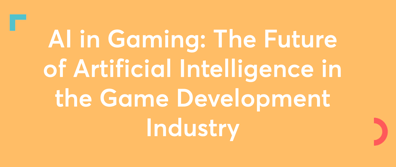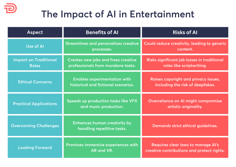Why Businesses Should Invest in AI or Risk Getting Left Behind
- 13 Jan 2025
- 10 mins read
- Posted in
Updated 26th of August 2025
Content
- Why should a business invest in AI?
- Why AI is No Longer Optional for Businesses
- Practical Applications of AI in Business
- Overcoming the Challenges of AI Adoption
- Real-World Examples of AI Success
- AI and the Future of Work
- How to Start Investing in AI Today
- Final Thoughts – Act Now or Risk Being Left Behind
Why should a business invest in AI?
AI systems enable businesses to cut operational costs by automating workflows and reducing manual labor across functions like customer service and finance. In today’s landscape, the better question is – why not? The advanced AI technology available right now can streamline processes and workflows like never before, helping you automate tasks, improve decision making, enhance customer satisfaction and drive a whole host of other benefits.
These advantages can free up precious human bandwidth, empowering your team to engage in creativity, come up with more exciting innovations and strategize in more effective ways.
What’s more – today, it’s easy for anyone to adopt AI technology. Gone are the days when AI adoption was only for corporate giants who could spend millions on developing custom algorithms for their business. With the vast array of AI automation tools and software available, SMEs can now leverage these advantages as well.
Why AI is No Longer Optional for Businesses
The Competitive Advantage of Early AI Adoption
AI is at a tipping point right now. With more and more businesses across diverse sectors adopting AI technology, the scope of innovation will only get bigger. This means, early adoption can only get you more competitive advantages.
The costs associated with AI software are reasonable enough right now that even SMEs can consider it. This means young businesses can tap into the benefits while their company is still at a nascent stage, driving ROI over a longer period. It also empowers them to make more data driven decisions for growth. For example – predictive analytics can offer insights on how to make hiring decisions to optimize your team, what kind of inventory to maintain, where to allocate your resources and so on. No need for costly trial-and-error, trying to figure these out!
Another advantage of early adoption of AI is that it can be foundational to your business strategy, informing processes and driving efficiencies now – rather than struggling to tack on AI models to already established processes later. This reduces the need for unnecessary change management and friction.
Finally, early adoption of AI empowers you to be thought leaders and disruptors in your industry. It lets you actually lead change rather than playing catch-up.
What Happens If Businesses Ignore AI?
The risks of not adopting AI may not actually be severe in the short term. But the real chasm opens up with time – early adopters can use these innovations to drive down inefficiencies, increase output, and scale up at a faster pace, leaving competitors far behind.

While early adopters make use of predictive insights, businesses that ignore AI will have to learn business lessons the hard way while incurring higher operational costs that affect the bottomline. They may also experience missed opportunities with customers – failing to offer the kind of personalized, innovative services and support that their competitors are offering. Compliance and data security is also getting more complex, and it can be tough to stay ahead of these without AI assistance in the future.
In fact, staying ahead of changing trends is one reason why a lot of leaders are adopting AI – 58% of IT leaders surveyed in the UK report concerns about being left behind if they don’t invest in the technology now.
Practical Applications of AI in Business
Automating Routine Tasks for Efficiency
Every business has those tedious tasks that team members dread – unavoidable operational work that suck up a lot of their time and add to their workdays, but they ‘need to be done’ nevertheless. The good news is, they don’t necessarily need to be done by humans anymore!
For instance, tools like Otter.ai offer meeting and call transcription capabilities. This makes it easier for your team members to skim through past calls, revisit relevant parts of the discussion, and refer to slides that were presented – without having to play back the entire recording of the meeting.
Busy teams always find it difficult to stay ahead of rapidly changing workdays. Scheduling tools like Motion make this easier by planning tasks, managing calendars, prioritizing your work for you as new things come up, and track meetings and deadlines. This means no more managing diaries and calendar clashes, no missed meetings, and no struggling with over-scheduled workdays!
Enhancing Customer Service with AI
Customer service is another space that’s seeing dramatic change with the advent of AI. Customer support lines that function only between 9-5 on weekdays are quickly becoming a thing of the past – with AI chatbots, speech recognition technology and natural language processing making it possible to provide automated support 24*7, without human intervention.
AI automation tools like Freshchat and Kustomer enable you to engage with your customers in real-time and more meaningfully – catering to their needs and offering a personalized experience, all while generating reports and integrating CRM capabilities into the process. This lets you take a holistic approach to customer service and help people when they actually need it, without putting undue stress on your team.
Improving Decision-Making and Data Analysis
AI technology offers highly sophisticated data analytics and predictive capabilities that you can use to develop tailored strategies, specifically for your brand. For example, marketing teams can now input demographic data into customer segmentation tools to generate statistical insights and create consumer personas more effectively. This makes it possible to craft more efficient data-driven marketing strategies.
Predictive algorithms can be used to generate more accurate demand forecasts – enabling you to manage your inventories, plan for future staffing needs and so on.
When it comes to hiring and staffing decisions too, there are tools that can make it easier. For example, employers often find it beneficial to manage fluctuating demands by opting for the services of freelance professionals, rather than making full-time hires. AI-backed tools like Phoenix makes it easier for you to discover talented freelance professionals – all matched to your exact needs. Businesses that use these capabilities are able to meet changing business demands quickly without having to devote human bandwidth.
Overcoming the Challenges of AI Adoption
Addressing Cost and Implementation Concerns
Today, most AI tools and software come with pretty reasonable subscription models – enabling businesses to start using them without too many cost consideration discussions involved. However, just having individual tools does not make for a smart AI strategy. That may require some software integration and organizational alignment, which can involve a greater upfront investment.
But when planned right, these costs can be offset and implementation streamlined. To do this, you will need to first carry out a thorough and unbiased assessment of your current infrastructure and capabilities. This lets you identify areas where AI technology can help. For example, finding out where your managers are spending too much time will let you make smarter investments in that area.
System integration is another thing to keep in mind. A call transcriber tool can generate lots of valuable customer data, but this is meaningless if you don’t have integrated CRM capabilities to capture and utilize those insights.
But perhaps the most important factor that will determine how successful your AI strategy will be, is your workforce. TalentDesk’s latest AI report finds that 25% of businesses are not taking any steps to prepare their workforce for the AI revolution. Ensure you communicate your AI strategy across the organization and provide the necessary training and support needed to embrace the new technological capabilities. This minimizes cultural resistance and encourages everyone to use the tools you have invested in – thus optimizing costs.
At the end of the day, early adoption and smart implementation of AI technology make your investments more cost-effective. You can use it across more departments and projects, spreading out the costs.
Managing Ethical and Data Privacy Risks
The ethical concerns that come with AI adoption are not to be ignored either. As more people start using AI models, their current shortcomings are becoming more obvious. One important example is algorithmic bias – it is possible for AI models to be biased, based on what training data is used.
This can lead to skewed results and unethical decision-making. Think racial profiling that denies financial services to people of color, or inappropriate language that finds its way into AI-generated marketing content. It is the responsibility of every business that uses AI to have the right measures in place to identify and moderate potential biases. This cannot be done without a formal responsible AI strategy.
Data privacy can be another major area of concern. Inputting your data into AI software can open it up to public access. This becomes an issue if your company uses a lot of proprietary data and IP-protected assets. Regulations such as GDPR also restrict how you store and use customer data – and feeding their personal details into open access AI automation tools can violate your consumers’ rights to privacy.
This is why it is important to have formal guidelines around data privacy and security. What’s more – these will need to be monitored on an ongoing basis and updated as newer data security nuances emerge. Clear, transparent processes and policies build trust among your customers, users and internal workforce alike.
Real-World Examples of AI Success
Case Studies of Businesses Thriving with AI
AI has been the great leveller of modern times. In the past, it has often been difficult for smaller, sustainable brands to stay competitive in the age of retail giants like Amazon. Now, with AI evening the playing field, SMEs can compete with industry giants and still stay relevant.
Nakie is one such brand that has written its own success story with AI. The brand manufactures hammocks and outdoor camping gear from recycled materials – and predictive data insights have been instrumental in their back-end logistics planning. Through accurate demand forecasts, they have been able to track their stock levels, and optimize their inventory, making sure that they always have enough stock to fulfil orders.
The brand’s success is also driven by a loyal customer-base – and AI has optimized this too. Nakie keeps its customers engaged by answering queries, responding to feedback and resolving issues quickly through AI-backed systems. They have been able to extract insights from reviews and feedback and use this to identify what their customers want them to improve upon. These personal touches help them stay ahead.
Similarly, Hong Kong based ride hailing service GetTransfer reaped the benefits of AI adoption, early on. They used machine learning right from their early days, to develop their driver bidding systems. Now, they have evolved to build a proprietary AI solution that helps their drivers price their services most efficiently – and be matched to customers looking for optimal pricing for their rides.
GetTransfer also uses AI tools to automate software testing, creating service level agreements and more. This reduces the human effort needed to scale, and has helped drive down costs – enabling the company to focus on new innovations and product launches. Today, GetTransfers services are available in 150 countries worldwide.
Learning from Brands That Fell Behind
Meanwhile, there are lots of cautionary tales that demonstrate what happens when brands fail to innovate. Blockbuster is a prime example.
There was a time when a weekend without Blockbuster was unimaginable. The video rental company was known for its extensive movie collection – and the introduction of their snack sections made them the go-to brand within the home entertainment industry. By the early 2000s, Blockbuster already had 9000+ stores globally, and over 45 million registered users.
So what went wrong? Missed customer insights was one stumbling block. Blockbuster’s revenue model was based on high late fees – meaning they made profits at the cost of customer dissatisfaction. This is where Netflix proved smarter with their subscription-based model.
A bigger issue was that the brand failed to change with the times and technology. Changing mindsets and faster digital innovation meant a shift towards convenience and flexibility in the entertainment industry. Blockbuster’s model continued relying on physical stores instead of embracing streaming innovations. This is again where Netflix proved smarter.
As a result, Blockbuster fell out of favor, with their stores shutting down rapidly over the later 2000s. By 2010, the company had declared bankruptcy.
AI and the Future of Work
AI as a Partner, Not a Replacement
‘Will AI replace humans?’ This question remains a concern for many professionals globally. Our own research shows that 60% of freelancers report apprehensions around being replaced. Realistically, however, AI needs to be looked at more as a partner or assistant rather than a replacement for workers.
We have discussed how AI excels at automating mundane, repetitive, and recurring tasks. But it still cannot create, innovate and come up with things that have never been done before – those still remain the forte of human professionals. And getting the tedious tasks out of the way actually frees up more time and mental bandwidth for human workers to do what they do best.
A designer no longer has to spend hours on tasks that do not require their expertise – they can turn to AI tools for things like color correcting, creating mock-ups or making minor adjustments on designs that they have already created. This affords them the space to come up with more fun and creative campaigns.
Doctors, radiologists and nurses can now use AI imaging capabilities to identify issues undetectable by the human eye. But spotting an anomaly is only a small part of the job – the skills of the medical professional are still required to put the findings in context and come up with an accurate diagnosis. Likewise, scientists and STEM professionals can use AI to speed up experimentation, analyze data and identify errors. But envisioning each new experiment or knowing what needs to be done differently still requires human judgement.
Creation and innovation are not the only areas where AI still falls short – sometimes, you just need that human touch and empathy to drive success. Case in point – AI has made the customer service space a lot more efficient. But a customer who is frustrated still wants to speak to a human being, not a machine.
Upskilling Employees for the AI Era
While AI will not replace human skills, there are some jobs that will be impacted more than others. This mainly includes roles that are based on repetitive tasks – like data entry or admin operations. However, as has historically been the case, the impacted jobs are likely to be offset by the creation of new roles in the AI era.
That said, this shift would involve upskilling and reskilling – and employers of the future will need to play a big role here. When workers are uncertain about their future in the company, they are more likely to push back against tech innovation. Transparency, proper support and access to training resources and guidance can create an encouraging atmosphere – one where people feel excited to learn and experiment with what AI technology can do. This makes it easier to nurture a flexible workforce that is open to growing and meeting the emerging needs of the business.
How to Start Investing in AI Today
Steps for Small-to-Medium Businesses to Begin AI Integration
Now that we have discussed the advantages and benefits of AI in creating business opportunities, how do you go about getting started? Many SMEs make the mistake of investing in AI – just because they want to avoid falling behind. But thoughtless AI adoption can be costly, without generating any real ROI for your business. The key is to take a planned out, strategic approach.
Pinpoint gaps in your day-to-day business operations. Identify where your current capability falls short and where your team members spend too much time. This can tell you exactly what you need to automate – and invest in those specific areas, ensuring enhanced ROI.
Get stakeholder buy-in. Align all your stakeholders and department heads on what changes you are looking to implement, and how it will leverage AI for productivity and better business outcomes. Once they are convinced and know their role in the strategy going forward, they can set the right tone for their teams and lead the charge on organization-wide AI adoption.
Formalize data privacy and security policies. Implementing AI-driven changes first and thinking about compliance later can spell trouble! Involve your tech, innovation and legal leads in formalizing robust policies around privacy and data security. Compromising privacy or IP rights (even inadvertently) can lead to hefty fines and settlements – which completely negates the economic advantages that you were aiming to achieve in the first place.
Final Thoughts – Act Now or Risk Being Left Behind
Preparing for a Competitive, AI-Driven Future
We’re now at a stage where no industry can reasonably expect to remain unimpacted by AI. Fields like tech, game development, entertainment and education, are already seeing changes in the way they work. Ignoring the revolution will not make it go away – it will just put you at risk of getting left behind. But jumping in head-first and investing in AI with no real plan of action is not the right way to go either.
The key is to make thoughtful investments that create efficiencies for your workforce today while also aligning with your long-term business goals. Developing a smart strategy for early AI adoption and fostering an environment of curiosity and excitement among your workers leaves you well placed to not only succeed – but potentially break new ground in your industry.

Sanhita Mukherjee
Tags
Frequently asked questions
Why should businesses invest in AI?
AI enhances efficiency, automates routine tasks, improves decision-making, and personalizes customer experiences. With accessible tools now available, even small and medium businesses can compete with industry giants by integrating AI into daily operations.
What are the risks of not adopting AI?
Businesses that delay AI adoption risk higher operational costs, missed growth opportunities, and losing out to more agile competitors. As AI becomes foundational to innovation, late adopters may struggle with outdated systems and declining relevance.
How can companies start integrating AI effectively?
Start by identifying operational gaps where AI can save time or reduce costs. Align stakeholders, set clear goals, and choose tools that integrate with existing systems. Don’t forget to formalize data privacy policies and provide training to your workforce.
Will AI replace human jobs?
AI is more likely to augment rather than replace human roles. It handles repetitive tasks, freeing teams to focus on creativity, strategy, and innovation. Success depends on upskilling employees and positioning AI as a tool, not a replacement.
Speak to us to find out how we can modernize your contractor management
Related articles

AI Knows You’re Burned Out Before You Do
See how AI prevents burnout by spotting early warning signs, reducing stress before it escalates, and supporting freelancers and teams.

31 Game-Changing AI Marketing Tools for 2025
Discover 31 game-changing AI marketing tools – from automation to personalization, these tools will revolutionize your campaigns and boost efficiency.

2024 Engineering Recap
See how we enhanced features and added automation in 2024 to improve TalentDesk user experience. Here's a full recap and a look ahead to 2025.

How AI is Transforming eLearning
See how AI is transforming eLearning with personalized experiences, content, and predictive analytics, enhancing education for students and teachers alike.

AI in Gaming: The Future of Artificial Intelligence in Game Development
The ultimate guide to AI in the gaming development industry. Learn how Artificial Intelligence is revolutionizing NPCs, game design, and player experiences.

Phoenix Rising: AI-Powered Freelance Talent Discovery Takes Flight
Discover Phoenix: the AI-powered assistant revolutionizing freelance talent discovery. Connect faster, smarter, and more securely with top freelancers.

Revolution or Disruption? The impact of AI in Entertainment & Media
Revolution or disruption? Our comprehensive article explores the risks & benefits of AI in entertainment & media. Read key industry insights and opinions.
Why AI Can't Replace Freelancers and Take Over Jobs
Why AI Can't Replace Freelancers and Take Over Jobs
Artificial intelligence tools like Chat GPT have people thinking their jobs are over, but AI can't replace human creativity & originality of a copywriter.
-1.png?width=650&height=167&name=right%20size%20banner%20(1)-1.png)
The World of Work: Our Top Predictions for 2023
As we enter the new year, we wanted to share our predictions for 2023 to help businesses develop better strategies in the coming year.
-1.png?width=650&height=167&name=HQ%20v02%20(2)-1.png)
What is a Distributed Team and how do you manage them?
Managing a distributed team can be a very complex task. The suite of distributed team management tools from TalentDesk can make this much easier!
